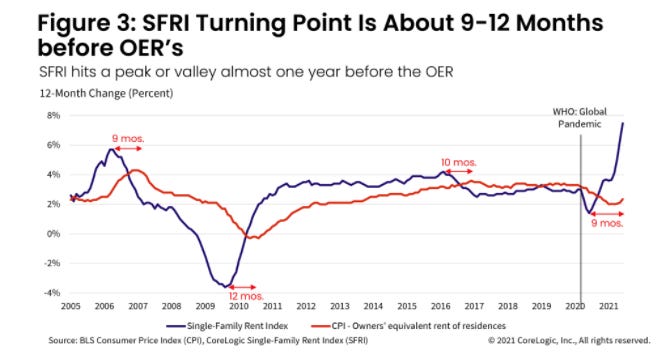Measuring Rents
How quickly are rents increasing? And how will this impact measures of inflation?
Earlier I wrote: The Rapid Increase in Rents, What is happening? Why? And what will happen.
Today, I’m going to take a step back and discuss measuring rents. Historically I’ve used Owners' equivalent rent of residences (OER) as a measure of rent (part of the monthly CPI report from the BLS). For example, when I present the house price-to-rent ratio, I use the Case-Shiller National index for house prices, and OER for rent.
However, several sources are reporting a recent sharp increase in rents, and the OER is not capturing this - yet.
First, here is a graph of several measures of rent since 2000: OER, Rent of shelter, Rent of primary residence, Zillow Observed Rent Index (ZORI), and ApartmentList.com. (all set to 100 in January 2017)
Note: For a discussion on how OER, and Rent of primary residence are measured, see from the BLS: How the CPI measures price change of Owners’ equivalent rent of primary residence (OER) and Rent of primary residence (Rent)
OER, Rent of shelter, and rent of primary residence have mostly moved together. The Zillow index started in 2014, and the ApartmentList index started in 2017. Here is a graph of the year-over-year (YoY) change for these measures since January 2015. All of these measures are through Aug 2021, except ApartmentList is through Sept 2021.
The Zillow measure is up 7.4% YoY as of August, and the ApartmentList measure is up 15.1% as of September. Both the Zillow measure (a repeat rent index), and ApartmentList are showing a sharp increase in rents. From Zillow:
“ZORI is a repeat-rent index that is weighted to the rental housing stock to ensure representativeness across the entire market, not just those homes currently listed for-rent.”
And from ApartmentList:
At Apartment List, we estimate the median contract rent across new leases signed in a given market and month. To capture how rents change in a market over time, we estimate the expected price change that a rental unit should experience if it were to be leased today.
Both of these measures reflect new leases, whereas most rental units don’t turnover every year (as captured by the BLS measures). Adam Ozimek, Chief Economist at @Upwork explained this succinctly:

But this sharp increase in new leases should spill over into the consumer price index over the next year. CoreLogic Chief Economist Frank Nothaft has an excellent discussion of rent on inflation: The Role of Rent in Inflation Measurement
[W]e have noticed that the owners’ equivalent rent generally lags the CoreLogic Single-Family Rent Index by nearly 12 months … If this relationship continues in the coming year, then the owners’ equivalent rent growth will quicken and be a headwind to lower inflation.
CoreLogic also tracks rents for single family homes: Single-Family Rent Growth Reaches Another Record High in July, CoreLogic Reports This index for single family homes.
July 2021 data shows a national rent increase of 8.5% year over year, up from a 1.7% year-over-year increase in July 2020.
And Rick Palacios Jr., Director of Research at John Burns Real Estate Consulting has provided some data on twitter. Quite a few cities are showing 10%+ rent growth for single family homes.


Clearly rents are increasing sharply, and we should expect this to spill over into measures of inflation in 2022. I’ll have much more on rents.








I wonder when rent prices hit a breaking point and we get social unrest or skyrocketing homelessness? Even a 1 bedroom apartment + utilities these days in a tier 2 city can take 50% of a persons income making $25/hr.